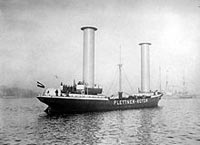
The E Ship 1 arrived in Dublin last week with a cargo of wind turbines manufactured by Enercon. What was striking was the ship itself, with four tall pillars rising vertically from the ship, two forward and two aft. The pillars are Flettner rotors, first developed in the 1920s by German engineer Anton Flettner. They are in essence, motor powered sails, 27 meters tall and 4 meters in diameter. The spinning vertical rotors develop aerodynamic lift using the Magnus effect. As the wind blows across the spinning rotors, they develop lift similar that of an airfoil shape of a conventional sail. Unlike masts and sails, however, the vertical Flettner rotor does not interfere with cargo operations. The Flettner rotors are expected to save 30-40% in fuel costs at 16 knots.
The E Ship 1 is owned by Enercon and is intended to demonstrate energy saving technology as well as to deliver Enercon wind turbine assemblies to customers. In addition to the Flettner rotors, the ship is powered by diesel engines driving twin propellers. Exhaust gas from the engines power a downstream steam turbine, which drives the four Enercon-developed Flettner rotors.

Buckau
The basic design of the Flettner rotor has been around for almost 90 years. Flettner applied for his patent on the design in 1922. The Flettner rotor ship Buckau set sail in 1925, first crossing the North Sea and then the Atlantic. While technically successful, the low cost of fuel and the limitations on bearing design made conventional ships more cost effective.
With advances in engineering and dramatically higher fuel costs, has the Flettner rotor finally arrived as a viable technology? Time will tell, though it is interesting to read the predictions of F.O. Willhofft, former Professor of Mechanical Engineering at Columbia University, as reported in the New York Times on May 3, 1925. In a paper given to the American Institute, he wrote:
“The outstanding fact is that rotating cylinders produce about ten times the propulsive force as canvas sails of the same area and that the actual results obtained in the trial trips of the Buckau confirmed the laboratory results with remarkable exactness.
“All that one can predict with certainty, basing the estimate with actual results obtained on the Buckau and on meteorological statistics, is that a motorship equipped with rotors will save not less than 25 percent on fuel , on the average, year after year, for the average trade route. I consider the Flettner rotor ship as a link only in the chain of evolution of the harnessing of wind power. “
Eighty five years later, the E Ship 1, may finally begin to prove Professor Willhofft right.

Pingback: Spec Tech: High Tech Sailing In Science Fiction « Clarion Blog
I am trying to establish whether the rotors are connected to the drive-shaft of the ship or do the rotors develop thrust which is transferred to the hull just as in a yacht?
Cheers,
David
The rotors are completely separate from the ship’s drive shaft. The spinning rotors create lift when wind blows around them by what is known as the Magnus Effect. The lift developed from the rotors is transferred to the hull the the sails of a a yacht.
Hi,
Just to say that it’s an amazing ship (E-SHIP 1). As I post this, it is just sitting on the dock at Leixoes (Portugal) loadind wind turbine propellers.
Cheers
So are the rotors powered by engine? Or does the wind spin them, which creates lift like a conventional sail? Its written in such a way, that I don’t completely understand – especially the motor powered sail?
The rotors spin at high speed driven by an electric or motor or diesel engine. The wind blowing across them generates lift which propels the ship.
On the ship BUCKAU , what were the original rotors constructed of (steel, wood, or some other material)?
Popular mechanics magazine of 1925, describes the rotors as steel columns.
Wind-Powered Rotor Ships Were Maritime Breakthrough of the 20s: Time Machine (March 1925)